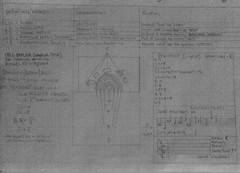
The first draft plan of a piece I am writing for the Birmingham Improvisers Orchestra (BIO).
It is based on the function of a eukaryotic cell (very simplified/abstracted). Still under construction and has not been rehearsed or tried out yet (might be too complex, better suited to a fully scored piece, we`ll see).
There are five instrumental groups, from the inside out..
Alpha: Nucleus (solo trumpet, produces 'DNA' for 'repairs')
Beta: Protein Sleeve (mid range woodwind; changes 'shape' to allow 'DNA' to be 'read')
Gamma: Internal Proteins (full range woodwind/brass; respond to receptor proteins, the proteins require 'repair' from the nucleus)
Delta: Membrane/Receptor Proteins (guitars, basses, perhaps some low woodwind; pick up enviromental 'signals' and change 'shape')
Epsilon: Environmental Signals (piano, percussion, electronics; provide input for the overall system)
Left to do is to work out exactly what Alpha and Epsilon should be. The environmental signals will be based on recursive/fractal ideas but with some probabilities involved, (stochastic), i.e. like 'nature', probably (may use an L-system or some 'grammar' too).
The 'DNA' on the draft above is a 12-tone row (I thought that at first just using the full chromatic would be good enough), however fairly soon I realised that it should be (of course) 23 pairs of notes or 22 pairs and two remainders, or maybe just a straight 46 (like chromosomes). So instead I will use a sieve or non-octave scale/sequence.
The contrast here is that the environmenal signals are structured to some extent (pitches and beats/groups) but are in general quite free/stochastic/chaotic, whereas the DNA sequence is more deterministic (more or less, the player will have some freedom in terms of durations and dynamics but the pitch order is fixed).
The piano will play the major 'outside' role (calculated harmonies and note groupings, free duration, dynamics and choice of sections) while the solo trumpet will be the internal motor so to speak (repairing the internal proteins when they have 'run down').
The other environmental signals like the percussion will play in groups of notes based on fibonacci sequences (1,1,2,3,5,8,13,21,...) or something similar (golden strings perhaps or something based on a stochastic L-system).
This element will not need scoring really, only requires basic counting (with each player using different but related numbers perhaps)
All of the 'proteins' (most of the musicians) will improvise freely around the material provided (that which applies to them, so the receptors will respond to the signals, the sleeve and the internal proteins to both the signals and DNA, using their ears to mimic and develop the musical ideas)
It should be quite simple to play for the musicians and to understand for the audience (the audience should see the progress from the outside in and back out again and should be able to hear the difference in the two types of inputs, 'signals' and the 'DNA' sequence)
Only the pianist (signal) and the solo trumpeter (DNA) will need to be able to 'read' (and only loosely, mostly to specify pitches/harmonies)
Each musician has clear and simple instructions around which he/she can improvise, this aggregates into a larger unit (the cell, which is more complicated to explain in the abstract, see above)
It probably sounds more complex/difficult than it will actually sound (hopefully anyway, like a computer is complicated but easy to use).
I have other scores for improvising orchestras on the way based on various linear types of processes/events, will see how this one goes first.
All this is copyrighted by me (Edward Lawes), from now (well, from about 3 months ago actually). If Celine Dion does a version and makes millions I want in.
[p.s. any biologists who may be reading this, please feel free to comment if you think I have got the cell structure and function totally wrong, I dont mind if it is a simplied abstract version of a cell but I dont want it to be completely inaccurate or misleading etc, that would be silly]




No comments:
Post a Comment